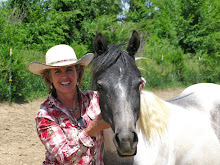 |
| Inanna, wild horse filly |
 |
| Red Boy(temporary name), wild horse colt |
Sourced by my desire to photo-journal, advocate and educate about the current state of our wild horses, I have wanted to have the privilege of personally knowing and raising a wild horse.
About a month ago, I mentioned this to one of my cowgirl friends, and she said, “I know two mustang babies that need a home.” She went on to tell me that two domesticated mustang mares owned by a ranch in Craig, Colorado, had been impregnated by a wild stallion from the Sand Wash Basin that jumped the fence. The Sand Wash Basin is a Herd Management Area, where approximately 400 wild horses are managed by the Bureau of Land Management, the governing agency for our National Wild Horse and Burro program.
About a month ago, I mentioned this to one of my cowgirl friends, and she said, “I know two mustang babies that need a home.” She went on to tell me that two domesticated mustang mares owned by a ranch in Craig, Colorado, had been impregnated by a wild stallion from the Sand Wash Basin that jumped the fence. The Sand Wash Basin is a Herd Management Area, where approximately 400 wild horses are managed by the Bureau of Land Management, the governing agency for our National Wild Horse and Burro program.
Robert and I drove up to Craig, Colorado this past weekend
to meet these beautiful, healthy and strong foals. The mothers are loving and gentle.
 |
| Inanna with her Mom |
 |
| Red Boy with his Mom |
This is a costly challenge every year for ranchers whose property abuts the wild horse herd management areas. The impregnated mares cannot work during the last part of their pregnancy, or the months that they are nursing their young. It becomes the rancher’s responsibility to care for these mares and their foals until such time as the babies can be weaned.
The stallions will figure out a way to get to the mares if they want to. Horses depend on their strong sense of smell and the body language of a mare to discern when she is in estrus (in heat and receptive to mate.)
 |
| "LIGHTNING", Sire of Inanna, Wild Sand Wash Stallion |
 |
| "SNOWMAN," (far right), possible Sire of Red Boy, Wild Sand Wash Stallion |
The stallions will figure out a way to get to the mares if they want to. Horses depend on their strong sense of smell and the body language of a mare to discern when she is in estrus (in heat and receptive to mate.)
If someone doesn’t take on these youngsters, the ranchers
are required to contact the BLM (Bureau of Land Management), and the baby wild
horses will be picked up and placed into the holding facilities. Currently,
we have over 49,000 wild horses standing in holding facilities across our
country!! This is a problem that direly
needs our attention.
So guess what! We are
adopting not one, but two 6 month old baby wild horses! We chose to adopt two rather than one because they know each other, and will have each other's companionship to support them as they adjust to life without their family band, and integrate into domesticated life on our ranch with our horses.
We will be bringing the foals up to our ranch in Lyons
sometime in the first week of July, when I will begin documenting their
development on a regular basis.
Happy Trails!
Deborah Inanna Krenza
Founder and Herd Queen
Gates of Inanna Ranch





0 comments:
Post a Comment